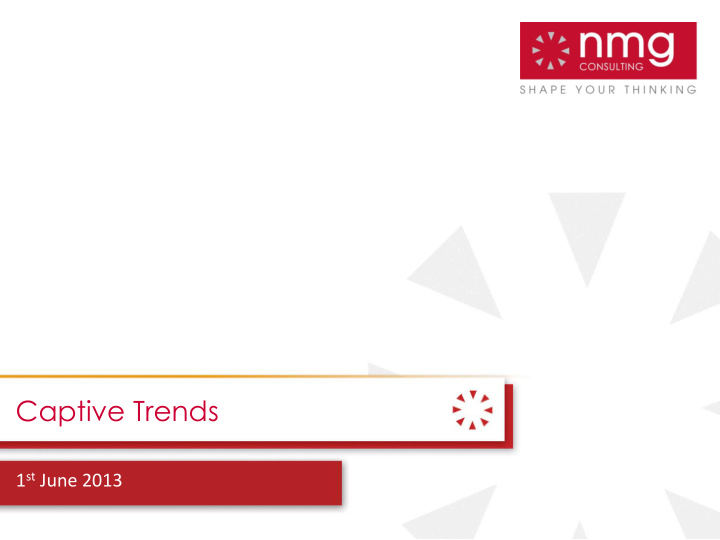



Captive Trends 1 st June 2013 1
Content ► What is a Captive ► Captive Structure ► Advantages ► Capitalisation and tax ► Domiciles ► Trends ► Contact 2
Captive Definition • A Captive is an insurance company that primarily insures the risks of businesses which are related to it through common ownership. The insured businesses pay premiums to the Captive in exchange for insurance. The Captive can be owned by the business owner or any related entity. • A Captive is able to purchase its own insurance which provides the Group with access to the reinsurance market and may enable substantial savings on its insurance premiums. • Captives are normally located in low tax domiciles, which adds to the overall value generation of a Captive structure. 3
Captive Structure 4
Captive Structure (2) Captives may insure the subsidiaries directly. Alternatively, a Captive reinsures a professional insurer that insures the subsidiaries, which is a legal requirement in many jurisdictions The Captive retains a part or all of the risks. Risks that are not retained with the Captive are reinsured to professional reinsurers. Captives usually have the same ultimate parent than the insured and are fully consolidated. 5
Captive Structure (3) Some jurisdictions require a A- rating for reinsurers in order to insure local insurers In this case, an A- rated reinsurer is required as Captives are usually not rated This makes the Captive structure more expensive Examples of jurisdictions requiring an A- rating are Russia and Korea 6
Advantages Savings of insurance premiums Access to the reinsurance market Cash remains in the consolidation circle Claims might be settled faster Stabilizing of risk financing costs over time Tax advantages possible Financing risks at group level Higher or total independence from insurance market over medium term Funding of non-insurable risks possible 7
Advantages (2) A Captive enables the owner to separate the risk retention of the subsidiary and the group Risk Exposure Maximal possible Risk transfer to retention of group (Re-)Insurance market Optimal retention of group Self retention in captive Subs 3 Subs 4 Local deductibles Subs 1 Subs 2 8
Solvency and Tax Example Singapore Minimum Capitalisation SGD 400,000, the insurance regulator (MAS) may require higher capitalization Solvency For Non-Singapore risks: Net assets of SGD 400,000 For Singapore based risks, the maximum of: 1. SGD 400,000 2. 20 percent of Net premiums written 3. 20 percent of net reserves Tax Captives can choose between: 1. Corporate income tax of 17 percent, 2. Concessionary tax rate for offshore risks for insurer for ten years, 3. Tax exemption for offshore business for Captives 9
Captive Domiciles ► The main domiciles in Asia are Singapore, Labuan and Micronesia ► Micronesia is tailor made for Japanese clients and the fastest growing domicile ► Tax rates differ, no tax is not always best for Captive owners Singapore Labuan Micronesia Bermuda Tax 17, 10 or 0 percent 3% 21% NIL Related third Third part business Restricted Case by case Case by case party Operating cost attractive attractive attractive High PCC legislation No Yes MCC Yes Infrastructure excellent good good excellent Investment restrictions None None reasonable None Loan Back unlimited limited max 50 percent limited 10
Captive trends ► Premium rates remain low in Asia ► Captive growth in Asia remains slow ► Captive domiciles in Asia increase service offering, PCC legislation in Labuan, and new Captive domicile in Micronesia ► Legislation and tax issues become more complex ► Independence of consultants and managers from brokers becomes more important to avoid conflicts of interest ► Cost of capital of professional insurers increase while the cost of capital remains lower for Captives ► Existing Captive increase use of their Captive 11
Contact Please contact us at: NMG Risk Solutions Daniel Koepfer , CFA, ACII Partner T: +65 6325 9872 M: +65 9726 6116 65 Chulia Street #37-07/08, OCBC Centre, Singapore 049513 Daniel.Koepfer@NMG-group.com http://www.NMG-Group.com 12
Recommend
More recommend